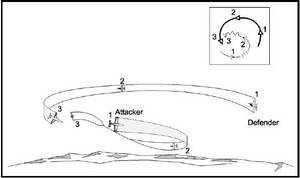| Part of a series on |
| Aircraft |
|---|
The low Yo-Yo is one of the most useful maneuvers, which sacrifices altitude for an instantaneous increase in speed. This maneuver is accomplished by rolling with the nose low into the turn, and dropping into a steeper slice turn. By utilizing some energy that was stored in the vertical plane, the attacker can quickly decrease range and improve the angle of the attack, literally cutting the corner on the opponent's turn. The pilot then pulls back on the stick, climbing back to the defender's height. This helps slow the aircraft and prevents an overshoot, while placing the energy back into altitude. A defender spotting this maneuver may try to take advantage of the increase in AOT by tightening the turn in order to force an overshoot.[1][2] The low Yo-Yo is often followed by a high Yo-Yo, to help prevent an overshoot, or several small low Yo-Yos can be used instead of one large maneuver.[3]
- ↑ "Chapter 10 Low yo yo". FLIGHT TRAINING INSTRUCTION. NAVAL AIR TRAINING COMMAND. Archived from the original on June 5, 2011.
- ↑ Sick's ACM School: Maneuvers Explained Archived August 31, 2009, at the Wayback Machine. 352ndfightergroup.com. Retrieved on 2010-10-23.
- ↑ Shaw, Robert (1985). Fighter combat : tactics and maneuvering Annapolis, Md: Naval Institute Press. ISBN 978-0-87021-059-4. p. 73
